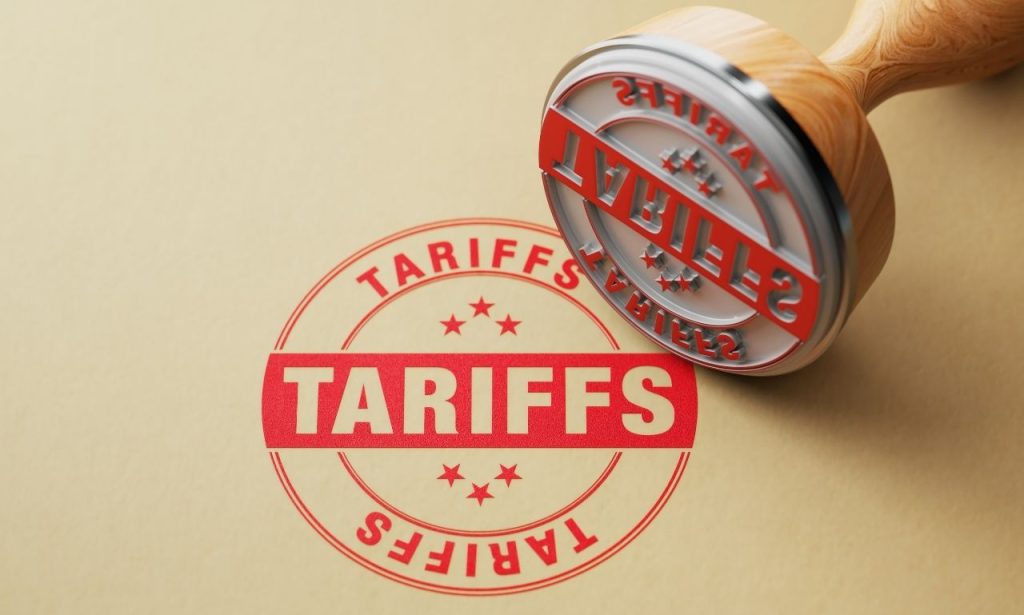Meta Description: Discover how tariffs affect real estate and the property management industry through impacts on materials, markets, and investment strategies. The real estate market doesn’t exist in a vacuum. Global trade policies shape our housing markets in surprising ways. Tariffs, once a footnote in economic discussions, now take center stage in property conversations. Today, we’ll examine how tariffs affect the real estate and property management industry. real estate landscape. You’ll learn why your rent might increase next year. We’ll explore why that commercial property downtown sits unfinished. The connections between international trade and your monthly mortgage might surprise you.
What are Tariffs?

Tariffs are taxes imposed on imported goods and services. They function as a fee paid by companies bringing products into a country. The importing business typically pays this cost directly to the government.
These taxes serve multiple purposes in our economy. Some tariffs aim to protect domestic industries from foreign competition. Others function as retaliation against unfair trade practices by other nations.
The government collects tariffs at ports of entry. The rate varies depending on the product type and country of origin. Some items face a 10% tariff, while others might see rates exceeding 25%.
Throughout history, tariffs have been controversial economic tools. They create winners and losers across different sectors. American steel producers might benefit while homebuilders suffer from the same policy.
Tariffs often trigger reciprocal actions from trading partners. For example, when we tax Canadian lumber, they might tax American agricultural products. This back-and-forth can escalate into broader trade tensions.
Effects of Tariffs on Real Estate
Direct Effects of Tariffs on Building Materials
The construction industry relies heavily on imported materials. Steel tariffs have increased framing costs by nearly 20% since implementation, and lumber tariffs pushed prices up almost 35% during peak periods last year.
These material cost increases hit builders immediately. A typical single-family home requires about 14,000 board feet of lumber. Even small percentage increases translate to thousands in additional costs.
The ripple effects reach beyond the obvious materials. Appliances, fixtures, and finishes also face tariff impacts. For example, a kitchen renovation might cost $3,000 more simply due to tariffs on imported goods.
Developers must choose between absorbing these costs and passing them along. Most choose the latter, resulting in higher home prices. Due to tariff-related costs, new construction in Denver saw price tags increase by an average of $18,000.
Small builders feel these impacts most acutely. They lack the purchasing power to negotiate better prices, and many smaller construction companies have reduced their project pipelines or shut down entirely.
Certain regions face disproportionate effects from specific tariffs. West Coast markets rely heavily on Asian imports. Midwestern builders depend more on Canadian lumber and steel products.
Timing proves particularly challenging for ongoing projects. Contracts signed before tariff implementation still require completion at the original price. This scenario has pushed some developers into financial distress.
Slower Housing Market Activity
Higher construction costs inevitably translate to higher home prices. The median new home price increased 8.4% year-over-year, primarily due to material cost increases. Fewer buyers can afford these elevated prices in today’s market.
Mortgage applications declined 12% following recent tariff announcements. Lenders report qualified buyers backing out during contract phases. The uncertainty around future pricing makes commitment difficult.
The existing home market also feels these effects indirectly. Renovation costs have climbed for current homeowners, and many choose to delay improvements rather than pay premium prices.
Potential sellers hesitate to list their homes because they worry about finding affordable replacement properties. This hesitation further reduces available inventory in already-tight markets.
First-time homebuyers face the most significant challenges. They typically have less financial flexibility for increased costs. The entry-level market segment has contracted the most since tariff implementation.
Construction timelines stretch longer due to material availability issues. Builders report waiting weeks for previously stocked items. These delays compound financing costs throughout the building process.
Impact on Rental Markets
The rental sector experiences unique pressures from tariff policies. Construction slowdowns reduce new apartment inventory. This supply constraint pushes rental rates higher in most major markets.
Property managers face increased maintenance and renovation costs. Replacing appliances, fixing plumbing, and regular upkeep all cost more. These expenses eventually transfer to tenants through higher rents.
Multi-family developers have scaled back plans for new communities. Several major projects in Atlanta and Phoenix have been postponed indefinitely. The numbers simply don’t work with current material prices.
Rental property investors calculate different returns under these conditions. Cap rates compress when operating expenses rise faster than rents, and some markets no longer attract the investment dollars they once did.
Affordable housing projects suffer the most severe consequences. Their tight margins can’t absorb material cost increases. Several tax-credit housing developments have been abandoned despite approved funding.
Tenants feel these effects directly affect their monthly budgets. Nationally, the average rent increased 6.7%, outpacing wage growth. More households now spend over 30% of income on housing costs.
College towns and high-growth cities show the most dramatic rent increases. Areas with limited buildable land cannot offset supply constraints. Some markets have seen double-digit percentage rent growth.
Regional and Economic Impacts
Based on their economic profiles, different regions experience tariff impacts. Rust Belt cities with manufacturing bases might benefit from specific protectionist policies. Their housing markets have shown surprising resilience.
Coastal cities dependent on trade face steeper challenges. Seattle’s construction industry cut 5,200 jobs following aluminum and steel tariffs. San Francisco has seen a 23% drop in building permit applications.
Border communities maintain unique economic relationships with trading partners. Cities like El Paso report significant construction slowdowns. Their economies traditionally operated across national boundaries without friction.
Rural areas face distinct disadvantages under tariff regimes. They typically have fewer material suppliers and limited options, and transportation costs compound when alternate sources must be found.
The economic uncertainty from changing trade policies dampens confidence. Developers hesitate to commit to significant projects without stable cost projections. This caution slows economic activity beyond just construction.
Labor markets interact with material challenges in problematic ways. Restrictions on immigration reduce the number of available construction workers. The combination of labor and material pressures creates perfect storms in some markets.
Specific industries adjacent to real estate face concentrated impacts. Furniture manufacturers, appliance makers, and fixture producers all struggle, further complicating the real estate ecosystem.
Long-Term Effects
The real estate industry must adapt to potentially permanent changes. Building technology will evolve to reduce dependence on tariffed materials, and alternative construction methods like modular housing may gain traction.
Material substitution happens when certain imports become too expensive. Developers seek domestic alternatives where possible. This shift gradually reshapes supply chains across the industry.
Domestic production capacity takes years to develop, and new American steel mills don’t appear overnight. The transition period creates prolonged pricing pressure in specific material categories.
The geographic distribution of real estate investment may permanently change. Areas with better access to domestic materials gain advantages, while regions heavily dependent on imports may see persistent underperformance.
Consumer preferences will adjust to new price realities. Home sizes have already begun to shrink slightly. Buyers accept fewer premium features to keep overall costs manageable.
The rental versus ownership calculus shifts for many households. Higher purchase prices push more people toward long-term renting. This trend has implications for community stability and wealth building.
Innovation accelerates when traditional approaches become too costly. Several builders have pioneered 3D-printed home components. These technologies may mature faster under tariff pressure.
Why Tariffs Matter for Commercial Real Estate

Commercial real estate faces unique challenges from trade policies. Office construction costs have risen 15% since tariff implementation, affecting project viability and investment returns.
Retail properties must account for changing consumer spending patterns. When tariffs affect household budgets, discretionary spending declines. This shift impacts retailer viability and, therefore, property values.
Industrial real estate presents a more complex picture. Manufacturing tariffs boost domestic production needs, and warehouse demand shifts as supply chains reorganize around trade policy.
Hotel development has slowed considerably in response to material costs. Several major chains report reducing their expansion plans. Rising costs and uncertain travel patterns create caution.
Under these conditions, commercial loans face additional scrutiny. Lenders require larger contingency budgets for construction projects, and financing costs increase alongside material expenses.
Foreign investment in commercial properties has declined noticeably. Uncertain trade relationships make cross-border investments riskier, and some markets previously dependent on foreign capital have struggled.
Lease structures increasingly address material cost volatility. New commercial leases often include provisions for renovation cost sharing. Tenants and landlords negotiate who bears these uncertain expenses.
What Could the Government Do to Offset Rising Prices?
Government intervention could counterbalance some tariff impacts. Tax incentives for domestic material production might increase supply. This approach takes time but could eventually moderate prices.
Infrastructure investment creates opportunities despite tariff challenges. Public projects could prioritize domestic materials. This strategy supports both construction employment and material production.
Targeted exemptions for certain building materials would provide immediate relief. The government could carve out specific categories from tariff schedules. This approach helps construction without undermining broader trade policy.
Expedited permitting and reduced regulatory burdens lower development costs. These administrative changes offset some tariff-related increases. Several states have already implemented such measures.
Federal financing programs could expand to address affordability impacts. Enhanced FHA and VA loan options help buyers manage higher prices. These programs require funding but leverage existing infrastructure.
Worker training programs address the skilled labor shortage. More qualified tradespeople eventually reduce labor costs. This reduction helps offset some material price increases.
Interest rate policy significantly affects real estate despite tariff pressures. The Federal Reserve considers broader economic impacts when setting rates. Lower rates partially counterbalance higher material costs.
Conclusion
Tariffs create complex crosscurrents throughout real estate markets. Their immediate effects on material costs ripple through the entire industry, and both homebuyers and renters ultimately feel these impacts.
Property managers must navigate this changing landscape carefully. Strategic material purchasing and renovation timing become critical skills. Successful professionals will adapt rather than simply react.
Investors should recognize these challenges as potential opportunities. Market dislocations create entry points in overlooked areas, and the wisest players will position themselves ahead of policy shifts.
The coming years will reshape how we build and manage real estate. Domestic supply chains will strengthen while international relationships evolve. New construction techniques will emerge from necessity.
Your awareness of these dynamics provides a valuable perspective. Whether buying a home, managing property, or investing in real estate, understanding tariff impacts matters. The most informed participants will make the best decisions in this changing environment.
Also Read: How to Choose the Right CRM for Real Estate Agents
FAQs
Recent tariffs have increased average new home costs by $12,000 to $20,000 depending on location and materials used.
Commercial properties often face greater impacts due to higher steel usage and more specialized materials.
Material price changes occur almost immediately, while finished property prices typically lag by 3-6 months.
Switching proves challenging due to limited domestic capacity and established supply chains.
Eventually, yes, as property valuations adjust to reflect higher replacement costs.



